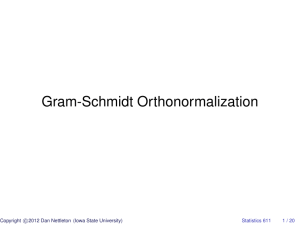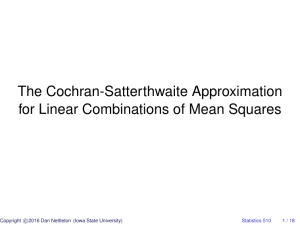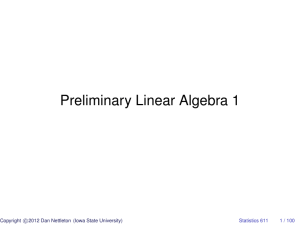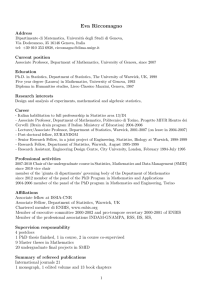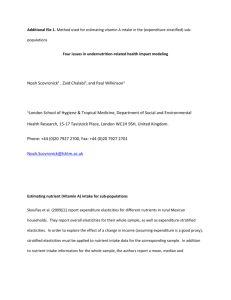Document 10639618
advertisement
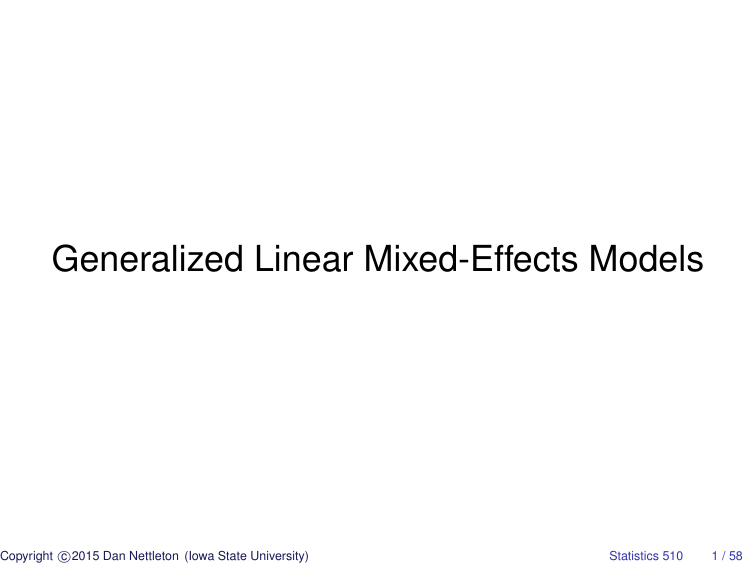
Generalized Linear Mixed-Effects Models
c
Copyright 2015
Dan Nettleton (Iowa State University)
Statistics 510
1 / 58
Reconsideration of the Plant Fungus Example
Consider again the experiment designed to evaluate the
effectiveness of an anti-fungal chemical on plants.
A total of 60 plant leaves were randomly assigned to treatment
with 0, 5, 10, 15, 20, or 25 units of the anti-fungal chemical, with
10 plant leaves for each amount of anti-fungal chemical.
All leaves were infected with a fungus.
Following a two-week period, the leaves were studied under a
microscope, and the number of infected cells was counted and
recorded for each leaf.
c
Copyright 2015
Dan Nettleton (Iowa State University)
Statistics 510
2 / 58
Our Previous Generalized Linear Model
We initially considered a Poisson Generalized LM with a log link
function and a linear predictor (x0i β) that included an intercept
and a slope coefficient on the amount of anti-fungal chemical
applied to a leaf:
yi ∼ Poisson(λi ),
log(λi ) = x0i β,
x0i = [1, xi ], β = [β0 , β1 ]0 ,
y1 , . . . , yn independent.
c
Copyright 2015
Dan Nettleton (Iowa State University)
Statistics 510
3 / 58
Overdispersion
We found evidence of overdispersion indicated by greater
variation among counts than would be expected based on the
estimated mean count.
We considered a quasi-likelihood approach to account for the
overdispersion, but another strategy would be to specify a model
for the data that allows for variation in excess of the mean.
c
Copyright 2015
Dan Nettleton (Iowa State University)
Statistics 510
4 / 58
A New Model for the Infection Counts
Let `i ∼ N(0, σ`2 ) denote a random effect for the ith leaf.
Suppose log(λi ) = β0 + β1 xi + `i and yi |λi ∼ Poisson(λi ).
Finally, suppose `1 , . . . , `n are independent and that y1 , . . . , yn are
conditionally independent given λ1 , . . . , λn .
c
Copyright 2015
Dan Nettleton (Iowa State University)
Statistics 510
5 / 58
The Lognormal Distribution
If log(v) ∼ N(µ, σ 2 ), then v is said to have a lognormal
distribution.
The mean and variance of a lognormal distribution are
E(v) = exp(µ + σ 2 /2)
and
Var(v) = exp(2µ + 2σ 2 ) − exp(2µ + σ 2 ).
c
Copyright 2015
Dan Nettleton (Iowa State University)
Statistics 510
6 / 58
Conditional Expectation and Variance
For random variables u and v,
E(u) = E(E(u|v))
and
Var(u) = E(Var(u|v)) + Var(E(u|v)).
c
Copyright 2015
Dan Nettleton (Iowa State University)
Statistics 510
7 / 58
A Lognormal Mixture of Poisson Distributions
Suppose log(v) ∼ N(µ, σ 2 ) and u|v ∼ Poisson(v).
Then the unconditional distribution of u is a lognormal mixture of
Poisson distributions,
E(u) = E(E(u|v)) = E(v) = exp(µ + σ 2 /2), and
Var(u) = E(Var(u|v)) + Var(E(u|v)) = E(v) + Var(v)
= exp(µ + σ 2 /2) + exp(2µ + 2σ 2 ) − exp(2µ + σ 2 )
= exp(µ + σ 2 /2) + (exp(σ 2 ) − 1) exp(2µ + σ 2 )
= E(u) + (exp(σ 2 ) − 1)[E(u)]2 .
c
Copyright 2015
Dan Nettleton (Iowa State University)
Statistics 510
8 / 58
E(yi ) and Var(yi ) in Our New Model for Infection Counts
E(yi ) = E(E(yi |λi )) = E(λi ) = exp(β0 + β1 xi + σ`2 /2).
Var(yi ) = E(Var(yi |λi )) + Var(E(yi |λi ))
= E(λi ) + Var(λi )
= E(yi ) + (exp(σ`2 ) − 1)[E(yi )]2 .
Thus, when σ`2 > 0, Var(yi ) > E(yi ).
c
Copyright 2015
Dan Nettleton (Iowa State University)
Statistics 510
9 / 58
The Probability Mass Function of yi
For y ∈ {0, 1, 2, . . .},
Z
∞
fi (y) = Pr(yi = y) =
Pr(yi = y|λi = λ)h(λ; x0i β, σ`2 )dλ
0
Z ∞ y
λ exp(−λ)
=
h(λ; x0i β, σ`2 )dλ
y!
Z0 ∞ y
λ exp(−λ)
1
−(log(λ) − xi0 β)2
p
=
exp
dλ,
y!
2σ`2
λ 2πσ`2
0
where h(λ; x0i β, σ`2 ) is the lognormal density of λi .
c
Copyright 2015
Dan Nettleton (Iowa State University)
Statistics 510
10 / 58
The Probability Mass Function of yi (continued)
There is no closed-form expression for fi (y), the probability mass
function of yi .
The integral in fi (y) must be approximated using numerical
methods.
The R function glmer in the package lme4 uses the Laplace
approximation (by default) to approximate the integral, but
glmer also permits the use of the more general integral
approximation method known as adaptive Gauss-Hermite
quadrature.
c
Copyright 2015
Dan Nettleton (Iowa State University)
Statistics 510
11 / 58
The Log Likelihood
The log likelihood is `(β, σ`2 | y) =
Pn
i=1
log{fi (yi )}.
Let f̃i (·) denote the approximation of fi (·). Then the approximate
log likelihood is
˜ σ 2 | y) =
`(β,
`
n
X
log{f̃i (yi )},
i=1
which can be maximized over β and σ`2 using numerical methods
to obtain MLEs of β and σ`2 and an estimated inverse Fisher
information matrix.
c
Copyright 2015
Dan Nettleton (Iowa State University)
Statistics 510
12 / 58
> library(lme4)
>
> leaf=factor(1:60)
>
> o=glmer(y˜x+(1|leaf),family=poisson(link = "log"))
>
> summary(o)
Generalized linear mixed model fit by maximum likelihood
Family: poisson ( log )
Formula: y ˜ x + (1 | leaf)
AIC
410.7283
logLik
deviance
417.0113 -202.3642
BIC
404.7283
c
Copyright 2015
Dan Nettleton (Iowa State University)
Statistics 510
13 / 58
Random effects:
Groups Name
leaf
Variance Std.Dev.
(Intercept) 0.4191
0.6474
Number of obs: 60, groups: leaf, 60
Fixed effects:
Estimate Std. Error z value Pr(>|z|)
(Intercept)
x
4.14916
0.15964
25.99
-0.15704
0.01252
-12.54
<2e-16 ***
<2e-16 ***
--Signif. codes:
0 *** 0.001 ** 0.01 * 0.05 . 0.1
1
Correlation of Fixed Effects:
(Intr)
x -0.788
c
Copyright 2015
Dan Nettleton (Iowa State University)
Statistics 510
14 / 58
> b=fixef(o)
> v=vcov(o)
> b
(Intercept)
x
4.1491634
-0.1570416
> v
2 x 2 Matrix of class "dpoMatrix"
(Intercept)
(Intercept)
x
x
0.025484034 -0.0015742367
-0.001574237
c
Copyright 2015
Dan Nettleton (Iowa State University)
0.0001567947
Statistics 510
15 / 58
> sigma.sq.leaf=unlist(VarCorr(o))
>
> sigma.sq.leaf
leaf
0.4191069
c
Copyright 2015
Dan Nettleton (Iowa State University)
Statistics 510
16 / 58
Conditional vs. Marginal Mean
The conditional mean of yi given `i = 0 is
E(yi |`i = 0) = exp(β0 + β1 xi ).
The marginal mean of yi is
E(yi ) = exp(β0 + β1 xi + σ`2 /2) = exp(β0 + β1 xi ) exp(σ`2 /2).
c
Copyright 2015
Dan Nettleton (Iowa State University)
Statistics 510
17 / 58
plot(x,y,xlab="Amount of Anti-Fungal Chemical",
ylab="Number of Infected Cells",col=4,cex.lab=1.5)
lines(xgrid,exp(b[1]+b[2]*xgrid),col=2)
lines(xgrid,exp(b[1]+b[2]*xgrid+sigma.sq.leaf/2),col=3)
legend(10,200,c("Marginal Mean","Conditional Mean"),
lty=1,col=c(3,2))
c
Copyright 2015
Dan Nettleton (Iowa State University)
Statistics 510
18 / 58
200
●
150
●
100
●
●
●
50
●
●
●
●
●
●
●
●
●
0
●
●
●
●
●
0
Number of Infected Cells
Marginal Mean
Conditional Mean
5
●
●
●
●
●
●
●
●
●
●
●
●
●
●
●
●
●
●
●
●
●
●
●
●
●
●
●
●
●
10
15
20
25
Amount of Anti−Fungal Chemical
c
Copyright 2015
Dan Nettleton (Iowa State University)
Statistics 510
19 / 58
Generalized Linear Mixed-Effects Models
The model for the infection counts is a special case of a
Generalized Linear Mixed-Effects Model (GLMM):
For i = 1, . . . , n, yi |µi has a distribution in the exponential
dispersion family with mean µi , and y1 , . . . , yn are conditionally
independent given µ1 , . . . , µn .
For some link function g(·),
g(µi ) = x0i β + z0i u, where u ∼ N(0, G)
and G is a variance matrix of known form that may depend on
unknown parameters (e.g., variance components).
c
Copyright 2015
Dan Nettleton (Iowa State University)
Statistics 510
20 / 58
In our model for the infection counts, we have . . .
conditional Poisson distributions,
µi = λi ,
g(·) = log(·),
z0i = the ith row of the n × n identity matrix,
u = [`1 , . . . , `n ]0 , and
G = σ`2 I.
c
Copyright 2015
Dan Nettleton (Iowa State University)
Statistics 510
21 / 58
Reconsider again the experiment designed to evaluate the
effectiveness of an anti-fungal chemical on plants.
Suppose the 60 plant leaves used in the experiment were
obtained by selecting two leaves from each of 30 plants.
Ten leaves obtained from five randomly selected plants were
assigned to each treatment (0, 5, 10, 15, 20, or 25 units of the
anti-fungal chemical).
Two weeks after fungal infection, the leaves were studied under
a microscope, and the number of infected cells was counted and
recorded for each leaf.
c
Copyright 2015
Dan Nettleton (Iowa State University)
Statistics 510
22 / 58
> d=data.frame(plant,leaf,x,y)
> head(d)
plant leaf x
y
1
1
1 0 30
2
1
2 0 57
3
2
3 0 23
4
2
4 0 118
5
3
5 0 212
6
3
6 0 132
> tail(d)
plant leaf x y
55
28
55 25 3
56
28
56 25 1
57
29
57 25 4
58
29
58 25 0
59
30
59 25 4
60
30
60 25 0
c
Copyright 2015
Dan Nettleton (Iowa State University)
Statistics 510
23 / 58
An Updated Generalized Linear Mixed-Mixed Model
All is as in the previous model on slide 5 except that now we
have
log(λi ) = x0i β + z0i u, where
z0i is the ith row of Z = [I30×30 ⊗ 12×1 , I60×60 ] and
p1
.
..
p30
u=
` ∼N
1
.
..
`60
c
Copyright 2015
Dan Nettleton (Iowa State University)
"
0
0
# "
,
σp2 I
0
0
σ`2 I
#!
.
Statistics 510
24 / 58
> o=glmer(y˜x+(1|plant)+(1|leaf),
family=poisson(link = "log"))
> summary(o)
Generalized linear mixed model fit by maximum likelihood
Family: poisson ( log )
Formula: y ˜ x + (1 | plant) + (1 | leaf)
AIC
412.2036
BIC
logLik
deviance
420.5810 -202.1018
404.2036
c
Copyright 2015
Dan Nettleton (Iowa State University)
Statistics 510
25 / 58
Random effects:
Groups Name
Variance Std.Dev.
leaf
(Intercept) 0.34426
0.5867
plant
(Intercept) 0.07414
0.2723
Number of obs: 60, groups: leaf, 60; plant, 30
c
Copyright 2015
Dan Nettleton (Iowa State University)
Statistics 510
26 / 58
Fixed effects:
Estimate Std. Error z value Pr(>|z|)
(Intercept)
x
4.15125
0.17157
24.20
-0.15725
0.01324
-11.88
<2e-16 ***
<2e-16 ***
--Signif. codes:
0 *** 0.001 ** 0.01 * 0.05 . 0.1
1
Correlation of Fixed Effects:
(Intr)
x -0.791
c
Copyright 2015
Dan Nettleton (Iowa State University)
Statistics 510
27 / 58
> b=fixef(o)
> v=vcov(o)
> vc=unlist(VarCorr(o))
> b
(Intercept)
x
4.1512534
-0.1572525
> v
2 x 2 Matrix of class "dpoMatrix"
(Intercept)
(Intercept)
x
x
0.029436558 -0.0017978827
-0.001797883
0.0001753472
> vc
leaf
plant
0.34425551 0.07413645
c
Copyright 2015
Dan Nettleton (Iowa State University)
Statistics 510
28 / 58
uhat=ranef(o)
uplant=unlist(uhat$plant)
uleaf=unlist(uhat$leaf)
plot(x,y,xlab="Amount of Anti-Fungal Chemical",
ylab="Number of Infected Cells",col=4,cex.lab=1.5)
lines(xgrid,exp(b[1]+b[2]*xgrid+uplant[3]+uleaf[5]),col=2)
lines(xgrid,exp(b[1]+b[2]*xgrid+uplant[3]+uleaf[6]),col=2)
lines(xgrid,exp(b[1]+b[2]*xgrid+uplant[30]+uleaf[59]),col=3
lines(xgrid,exp(b[1]+b[2]*xgrid+uplant[30]+uleaf[60]),col=3
c
Copyright 2015
Dan Nettleton (Iowa State University)
Statistics 510
29 / 58
150
●
100
●
●
●
50
●
●
●
●
●
●
●
●
●
0
●
●
●
●
●
0
Number of Infected Cells
200
●
5
●
●
●
●
●
●
●
●
●
●
●
●
●
●
●
●
●
●
●
●
●
●
●
●
●
●
●
●
●
10
15
20
25
Amount of Anti−Fungal Chemical
c
Copyright 2015
Dan Nettleton (Iowa State University)
Statistics 510
30 / 58
Now suppose that instead of a conditional Poisson response, we
have a conditional binomial response for each unit in an
experiment or an observational study.
As an example, consider again the trout data set discussed on
page 669 of The Statistical Sleuth, 3rd edition, by Ramsey and
Schafer.
Five doses of toxic substance were assigned to a total of 20 fish
tanks using a completely randomized design with four tanks per
dose.
For each tank, the total number of fish and the number of fish
that developed liver tumors were recorded.
c
Copyright 2015
Dan Nettleton (Iowa State University)
Statistics 510
31 / 58
d=read.delim("http://www.public.iastate.edu/˜dnett/S511/Trout.txt"
d
dose tumor total
1 0.010
9
87
2 0.010
5
86
3 0.010
2
89
4 0.010
9
85
5 0.025
30
86
6 0.025
41
86
7 0.025
27
86
8 0.025
34
88
9 0.050
54
89
10 0.050
53
86
11 0.050
64
90
12 0.050
55
88
13 0.100
71
88
14 0.100
73
89
15 0.100
65
88
16 0.100
72
90
17 0.250
66
86
18 0.250
75
82
19 0.250
72
81
20 0.250
73
89
c
Copyright 2015
Dan Nettleton (Iowa State University)
Statistics 510
32 / 58
●
●
0.8
●
●
●
●
●
●
0.6
●
●
●
0.4
●
●
●
0.2
●
●
●
0.0
Proportion of Fish with Tumor
●
●
0.05
c
Copyright 2015
Dan Nettleton (Iowa State University)
0.10
0.15
0.20
0.25
Dose
Statistics 510
33 / 58
A GLMM for the Tumor Data
Let mi = the number of fish in tank i.
Let yi = the proportion of fish in tank i with tumors.
ind
Suppose yi |πi ∼ binomial(mi , πi )/mi .
Then E(yi |πi ) = mi πi /mi = πi .
πi
Suppose log 1−πi = x0i β + z0i u, where . . .
c
Copyright 2015
Dan Nettleton (Iowa State University)
Statistics 510
34 / 58
A GLMM for the Tumor Data (continued)
x0i =
[1, 0, 0, 0, 0] if dose = 0.010
[1, 1, 0, 0, 0] if dose = 0.025
[1, 0, 1, 0, 0] if dose = 0.050 ,
[1, 0, 0, 1, 0] if dose = 0.100
[1, 0, 0, 0, 1] if dose = 0.250
β = [β1 , β2 , β3 , β4 , β5 ]0 ,
zi is the ith row of I20×20 , and
u = [u1 , . . . , u20 ]0 ∼ N(0, σu2 I).
c
Copyright 2015
Dan Nettleton (Iowa State University)
Statistics 510
35 / 58
A GLMM for the Tumor Data (continued)
Alternatively, we could introduce two subscripts (i = 1, 2, 3, 4, 5
for dose and j = 1, 2, 3, 4 for tank nested within dose) and rewrite
the same model as
ind
yij |πij ∼ binomial(mij , πij )/mij
log
πij
1−πij
= δi + uij
iid
u11 , u12 , . . . , u53 , u54 ∼ N(0, σu2 )
c
Copyright 2015
Dan Nettleton (Iowa State University)
Statistics 510
36 / 58
> d$dosef=gl(5,4)
> tank=factor(1:20)
> o=glmer(cbind(tumor,total-tumor)˜dosef+(1|tank),
+
family=binomial(link="logit"),nAGQ=20,
+
data=d)
c
Copyright 2015
Dan Nettleton (Iowa State University)
Statistics 510
37 / 58
> b=fixef(o)
> v=vcov(o)
> vc=unlist(VarCorr(o))
> b
(Intercept)
-2.559544
dosef2
2.075196
dosef3
3.136824
dosef4
3.896338
dosef5
4.269113
> round(v,3)
5 x 5 Matrix of class "dpoMatrix"
(Intercept) dosef2 dosef3 dosef4 dosef5
(Intercept)
0.046 -0.046 -0.046 -0.046 -0.046
dosef2
-0.046 0.060 0.046 0.046 0.046
dosef3
-0.046 0.046 0.060 0.046 0.046
dosef4
-0.046 0.046 0.046 0.065 0.046
dosef5
-0.046 0.046 0.046 0.046 0.071
> vc
tank
0.009590674
c
Copyright 2015
Dan Nettleton (Iowa State University)
Statistics 510
38 / 58
> #Estimated tumor probability for fish in a
> #"typical" tank (tank random effect = 0)
> #treated with 0.10 units (dose 4) is
>
> 1/(1+exp(-(b[1]+b[4])))
(Intercept)
0.7919621
c
Copyright 2015
Dan Nettleton (Iowa State University)
Statistics 510
39 / 58
> #Estimated distribution of tumor probabilities
> #for tanks treated with 0.10 units (dose 4):
>
> set.seed(5369)
> sim.tank.effects=rnorm(100000,0,sqrt(vc))
> sim.tumor.probs=1/(1+exp(-(b[1]+b[4]+sim.tank.effects)))
> hist(sim.tumor.probs,col="gray",probability=T,nclass=50,
+
ylab="Density",xlab="Tumor Probability",
+
main="Estimated Distribution for Dose=0.10")
> box()
> abline(v=1/(1+exp(-(b[1]+b[4]))),col=’blue’,lwd=2)
> abline(v=mean(sim.tumor.probs),col=’red’,lwd=2)
c
Copyright 2015
Dan Nettleton (Iowa State University)
Statistics 510
40 / 58
0
5
10
Density
15
20
25
Estimated Distribution for Dose=0.10
0.72
0.74
c
Copyright 2015
Dan Nettleton (Iowa State University)
0.76
0.78
0.80
0.82
0.84
Tumor Probability
Statistics 510
41 / 58
> #How would the picture change if the
> #tank standard deviation had been estimated
> #to be 1.0 instead of 0.0979?
>
> set.seed(5369)
> sim.tank.effects=rnorm(100000,0,1)
> sim.tumor.probs=1/(1+exp(-(b[1]+b[4]+sim.tank.effects)))
> hist(sim.tumor.probs,col="gray",probability=T,nclass=50,
+
ylab="Density",xlab="Tumor Probability",
+
main="Estimated Distribution for Dose=0.10")
> box()
> abline(v=1/(1+exp(-(b[1]+b[4]))),col=’blue’,lwd=2)
> abline(v=mean(sim.tumor.probs),col=’red’,lwd=2)
c
Copyright 2015
Dan Nettleton (Iowa State University)
Statistics 510
42 / 58
1.5
1.0
0.5
0.0
Density
2.0
2.5
3.0
Estimated Distribution for Dose=0.10
0.2
c
Copyright 2015
Dan Nettleton (Iowa State University)
0.4
0.6
0.8
1.0
Tumor Probability
Statistics 510
43 / 58
E(πij ) = E[logit−1 (δi + uij )]
1
= E
1 + exp{−(δi + uij )}
1
6=
1 + exp{−(δi + E[uij ])}
1
=
1 + exp(−δi )
= logit−1 (δi )
= E(πij |uij = 0).
c
Copyright 2015
Dan Nettleton (Iowa State University)
Statistics 510
44 / 58
Is the expected probability of a tumor the same for dose 4 and 5?
H0 : E(π4j ) = E(π5j )
1
1
=E
⇐⇒ H0 : E
1 + exp{−(δ4 + u4j )}
1 + exp{−(δ5 + u5j )}
⇐⇒ H0 : δ4 = δ5
⇐⇒ H0 : δ4 − δ5 = 0
c
Copyright 2015
Dan Nettleton (Iowa State University)
Statistics 510
45 / 58
Test of H0 : δ4 − δ5 = 0
> cc=c(0,0,0,1,-1)
> est=drop(t(cc)%*%b)
> est
[1] -0.372775
> se=drop(sqrt(t(cc)%*%v%*%cc))
> z.stat=est/se
> z.stat
[1] -1.763663
> p.value=2*(1-pnorm(abs(z.stat),0,1))
> p.value
[1] 0.07778872
c
Copyright 2015
Dan Nettleton (Iowa State University)
Statistics 510
46 / 58
Confidence Interval for δ4 − δ5
> est+c(-2,2)*se
[1] -0.79550322 0.04995314
How should we interpret this confidence interval?
Let u denote the random effect associated with any particular
randomly selected tank.
Let πk denote the probability that a randomly selected fish in the
randomly selected tank will develop a tumor if the tank is treated
with dose = k (for k = 4, 5).
c
Copyright 2015
Dan Nettleton (Iowa State University)
Statistics 510
47 / 58
Our model says log
π4
1−π4
= δ4 + u and log
π5
1−π5
= δ5 + u.
Thus,
δ4 − δ5 = (δ4 + u) − (δ5 + u)
π5
π4
− log
= log
1 − π4
1 − π5
π4
π5
= log
,
1 − π4 1 − π 5
which implies
π5
1−π5
π4
= exp(δ5 − δ4 ) 1−π
.
4
c
Copyright 2015
Dan Nettleton (Iowa State University)
Statistics 510
48 / 58
Confidence Interval for exp(δ5 − δ4 )
> exp(-est)
[1] 1.451758
>
> exp(-est+c(-2,2)*se)
[1] 0.951274 2.215556
For any given tank, the odds of tumor formation when dose = 5
are estimated to be 1.45 times the odds of tumor formation when
dose = 4. An approximate 95% confidence interval for this
within-tank multiplicative effect is (0.95, 2.22).
c
Copyright 2015
Dan Nettleton (Iowa State University)
Statistics 510
49 / 58
Previous Analysis of the Tumor Data
During our previous analysis of the tumor example, we fit a
Generalized Linear Model with a different binomial success
probability for each dose. (Call this the full model.)
To test
H0 : full model is adequate
we examined the residual deviance statistic
−2 log Λf ,s = 2`ˆs − 2`ˆf ,
where `ˆs and `ˆf are the log likelihood maximized under the
saturated and full models, respectively.
c
Copyright 2015
Dan Nettleton (Iowa State University)
Statistics 510
50 / 58
Previous Analysis of the Tumor Data (continued)
The residual deviance statistic −2 log Λf ,s = 2`ˆs − 2`ˆf is
approximately distributed as χ2n−pf under H0 , where n = 20 is
the dimension of the saturated model parameter space and
pf = 5 is the dimension of the full model parameter space.
Because the observed value of −2 log Λf ,s = 2`ˆs − 2`ˆf was
unusually large for a χ2n−pf random variable, we detected lack
of fit.
If the lack of fit is due to overdispersion, we now have two
different strategies for managing overdispersion.
c
Copyright 2015
Dan Nettleton (Iowa State University)
Statistics 510
51 / 58
Strategy 1: Use a Quasi-Likelihood (QL) approach.
Estimate an overdispersion parameter φ by
Pn 2
Pn 2
r
2`ˆs − 2`ˆf
i=1 di
=
or φ̂ = i=1 i .
φ̂ =
n − pf
n − pf
n − pf
To test a reduced model (r) vs. the full model (f ), compare
(2`ˆf − 2`ˆr )/(pf − pr )
φ̂
to an F distribution with pf − pr and n − pf degrees of
freedom.
c
Copyright 2015
Dan Nettleton (Iowa State University)
Statistics 510
52 / 58
Strategy 1: Quasi-Likelihood (QL) (continued)
To test H0 : Cβ = d, compare
c β̂)C0 ]−1 (Cβ̂ − d)/rank(C)
(Cβ̂ − d)0 [CVar(
φ̂
to an F distribution with rank(C) and n − pf degrees of
freedom.
c
Copyright 2015
Dan Nettleton (Iowa State University)
Statistics 510
53 / 58
Strategy 1: Quasi-Likelihood (QL) (continued)
To test H0 : c0 β = d, compare
c0 β̂ − d
q
c β̂) c
φ̂ c0 Var(
to a t distribution with n − pf degrees of freedom.
c
Copyright 2015
Dan Nettleton (Iowa State University)
Statistics 510
54 / 58
Strategy 1: Quasi-Likelihood (QL) (continued)
To obtain a 100(1 − α)% confidence interval for c0 β, use
q
c β̂) c,
c β̂ ± tn−pf ,1−α/2 φ̂ c0 Var(
0
where tn−pf ,1−α/2 is the 1 − α/2 quantile of the t distribution
with n − pf degrees of freedom.
c
Copyright 2015
Dan Nettleton (Iowa State University)
Statistics 510
55 / 58
Strategy 1: Quasi-Likelihood (QL) (continued)
If you use a QL approach, you are not fitting a new model.
Rather, you are adjusting the inference strategy to account
for overdispersion in the data relative to the original full
model you fit.
There is no point in re-testing for overdispersion once you
decide to use the QL inference strategy.
Data are still overdispersed relative to the fitted model, but
the QL inference strategy adjusts for overdispersion to get
tests with approximately the right size and confidence
intervals with closer to nominal coverage rates (in theory).
c
Copyright 2015
Dan Nettleton (Iowa State University)
Statistics 510
56 / 58
Strategy 2: Fit a GLMM
A GLMM with a random effect for each observation is one
natural model for overdispersed data.
We do not re-test for overdispersion once we decide to use
a GLMM with a random effect for each observation because
the model we are fitting allows for overdispersed data.
Because GLMM inference relies on asymptotic normal and
chi-square approximations, it may be more liberal (p-values
smaller and confidence intervals narrower) than the QL
approach, especially for small datasets.
c
Copyright 2015
Dan Nettleton (Iowa State University)
Statistics 510
57 / 58
Another Reason for Choosing a GLMM
In the last description of the experiment to study the effects
of an anti-fungal chemical, plants are the experimental units
and leaves are the observational units.
As was the case for experiments with normally distributed
responses, a random effect for each experimental unit
should be included in a model for the data when there is
more than one observation per experimental unit.
In the model for the infection count data, the plant random
effects allow for correlation between the responses of leaves
from the same plant.
c
Copyright 2015
Dan Nettleton (Iowa State University)
Statistics 510
58 / 58
